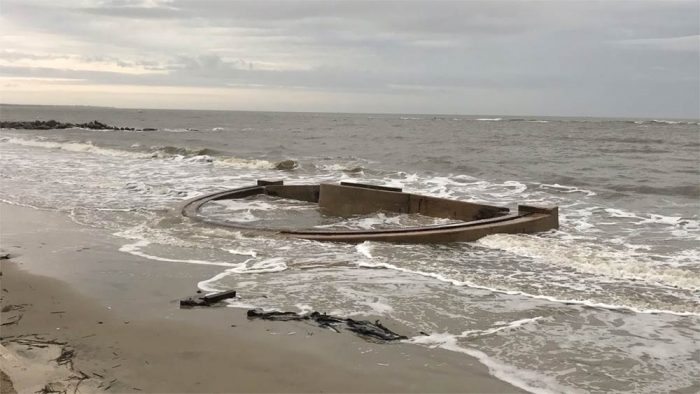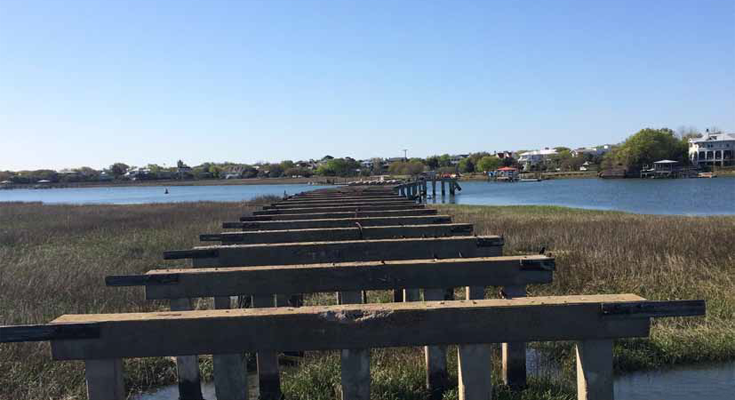
Our story on the Panama mount uncovered near Fort Moultrie by the waves spawned by Hurricane Florence drew lots of attention from our readers. It seems as though the relics of the past, as well as the area’s long history as a major port and ships that have been sunk in battle and storms stir the imagination of Lowcountry residents.
The story’s post on Mount Pleasant Magazine’s Facebook page reached 19,784 people, it had 220 shares and had 3,800 click throughs – inspiring us to further the conversation. Felicia Wardlaw Sperr commented, “Makes you wonder what else is out there that is yet to be uncovered. Never a dull moment in Charleston history!”
Russel Wallace said, “Super cool.” And Edie Newman exclaimed simply, “OMG!” Indeed.
The Panama mount, a circa-World War II coastal defense battery, was designed to be outfitted with 155-mm artillery guns to protect Charleston Harbor and the coastline in general from attack by sea. The structure was already partially visible, but the recent hurricane ripped away much of the sand that was covering the mini-fortification. The mounts were installed in what was called a sub-post of Fort Moultrie on the Marshall Reservation during World War II but were dismantled a few years later as coastal defense priorities changed.
Sullivan’s Island was a hotbed of wartime activity going all the way back to the American Revolution, when local militia beat back an invasion attempt in an area near the modern-day “breech” that separates Sullivan’s from Isle of Palms. During the Civil War, several battles took place near Charleston, and the world wars saw Fort Moultrie a part in the nation’s sea defense against German U-boats. It was reported that at least one U-boat was stalking shipping off Charleston during World War II, but, unlike the action on the mid-Atlantic coast, few ships were attacked along the Carolina shore.
Gary Alexander, a national park ranger at Fort Moultrie, said it is not surprising that buried military fortifications such as the Panama mount are being uncovered on Sullivan’s Island.
“The Army had a slew of these batteries all over the island, and we don’t even know where all of them were. There is even some talk that another Panama mount is actually under the porch of someone’s home near the beach,” he said.
And what lies off the Charleston-area beaches? A number of ships heading in and out of Charleston and plying the waters off Sullivan’s Island, Isle of Palms, James Island and Johns island, never made it home because of enemy action or storms.
Virginia Ellison of the South Carolina Historical Society said it is natural for the area offshore of Charleston Harbor to contain shipwrecks from various eras.
“The Charleston Harbor has been a bustling port since the founding of Charles Towne, with it being a major port of entry for newcomers – immigrants and enslaved – as well as exports and imports,” she pointed out.

She said the Historical Society collection contains accounts of a number of shipwrecks off the coast of Charleston. For instance, the Benjamin Maillefert business records include daily logs, accounts and employee accounts concerning salvage operations on wrecks in the Charleston Harbor, such as the USS Housatonic – which was sunk by the Confederate submarine H.L. Hunley – the USS Keokuk and USS Weehauken.
She added that the Historical Society fields numerous questions about shipwrecks off the Carolina coast.
“Our collection holds primary and secondary sources from personal accounts of wrecks to log books and ships’ journals,” she said.
It was with great fanfare that the H.L. Hunley was finally located and pulled in 2000 from the depths in the outer Charleston Harbor and later placed on display. At least three U.S. ironclads sunk off the coast of Charleston during the Civil War – the aforementioned Keokuk and Weehauken, and the Patapsco.
The Patapsco met its fate by a torpedo obstruction near Fort Sumter; the Weehawken went down south of Battery Wagner in the main shipping channel; and the Keokuk was an ironclad of experimental design that was destroyed at the entrance of the main shipping channel after being shelled by Confederate artillery on April 7, 1863.
According to sciencedaily.com, research of the Charleston Harbor area found remnants of the “First Stone Fleet” and Confederate blockade runners. Here’s how the website described the final days of the fleet:
“The First Stone Fleet, a series of New England whaling and merchant vessels filled with stone and intentionally sunk by Union forces to prevent Confederate blockade runners from entering the harbor. Research looked at 16 wrecks in the area, 13 of which were blockade runners. Remains of the blockade runners were reportedly in two clusters with two “outliers,” all wrecked along Maffitt’s Channel in attempts to elude Union blockaders.”
A wreck well-known to local divers is the Fredrick W. Day, a wooden schooner built in 1901 that sunk off the coast of Charleston on Sept. 17, 1914, loaded with bags of cement. When the ship sank, it turned upside down and now lies on her deck, keel toward the sky. Divers have found that after a century of tidal flow, there is nothing left on the wreck but hundreds of burlap bagged cement ballasts that were used to counterweight the ship’s sails.
All this and more await, although it may take a little effort to view what lies off Mount Pleasant, Charleston Harbor and the neighboring islands’ coastlines. Who knows what else the ceaseless waves and major storms will uncover.
By John Torsiello





Leave a Reply